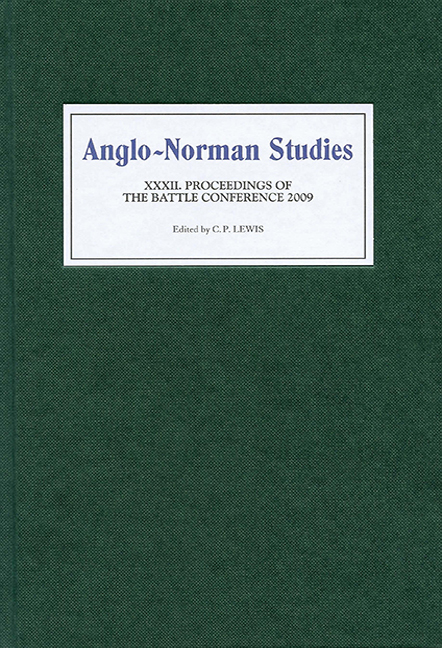Book contents
- Frontmatter
- Contents
- List of Maps and Tables
- Editor's Preface
- Abbreviations
- The Peace of God and Bishops at War in the Gallic Lands from the Late Tenth to the Early Twelfth Century
- Ad erudiendum tradidit: The Upbringing of Angevin Comital Children
- Coming and Going: The Use of Outdoor Space in Norman and Anglo-Norman Chronicles
- The Urban Transformation in England, 900–1100
- The Taming of the Laity: Writing Waltheof and Rebellion in the Twelfth Century
- Close Relations? Some Examples of Trade Links between England and the Towns and Ports of Lower Normandy in the Thirteenth and Early Fourteenth Centuries
- The Roots of the English Royal Forest
- Knighthood and Chivalry in the Histories of the Norman Dukes: Dudo and Benoît
- Prayers for the King and Royal Titles in Anglo-Norman Charters
- Domesday Mortlake
- Miscellaneous Endmatter
The Roots of the English Royal Forest
Published online by Cambridge University Press: 28 April 2017
- Frontmatter
- Contents
- List of Maps and Tables
- Editor's Preface
- Abbreviations
- The Peace of God and Bishops at War in the Gallic Lands from the Late Tenth to the Early Twelfth Century
- Ad erudiendum tradidit: The Upbringing of Angevin Comital Children
- Coming and Going: The Use of Outdoor Space in Norman and Anglo-Norman Chronicles
- The Urban Transformation in England, 900–1100
- The Taming of the Laity: Writing Waltheof and Rebellion in the Twelfth Century
- Close Relations? Some Examples of Trade Links between England and the Towns and Ports of Lower Normandy in the Thirteenth and Early Fourteenth Centuries
- The Roots of the English Royal Forest
- Knighthood and Chivalry in the Histories of the Norman Dukes: Dudo and Benoît
- Prayers for the King and Royal Titles in Anglo-Norman Charters
- Domesday Mortlake
- Miscellaneous Endmatter
Summary
For it [the forest] has its own laws, which are said to be based on the will of princes, not on the law of the whole kingdom, so that what is done under forest law is called just according to forest law, rather than absolutely just. Moreover, in the forests are the kings’ retreats and their greatest delights. For they go there to hunt, leaving their cares behind, to refresh themselves with a little rest. … The king's forest is the preserve of wild animals, not just any kind, but woodland creatures, and not everywhere, but in certain places that are suitable for them. That is why it is called ‘forest’, the ‘e’ of ‘feresta’ – that is, a place for wild animals – being changed into an ‘o’.
Richard Fitz NigelHistories of the English forest inevitably use Fitz Nigel's definition of the forest from his Dialogus de Scaccario of Henry II's reign as their reference point. In their supplement to Stubbs's Constitutional History on English forests, Ch. Petit-Dutaillis and Georges LeFebvre went so far as say that ‘the nature of the Forest could not be more clearly stated’, and H. A. Cronne wrote that there is ‘no more succinct definition of the Forest’.
Fitz Nigel's definition stresses three things: legal structures, royal hunting, and royal prerogative. He believed that noble love of the hunt was the only reason for the forests’ existence. Because scholars have tended to follow the lead of Fitz Nigel and similar legal texts, almost all histories of the English forest discuss it primarily as a royal hunting ground with its own legal system.
While Fitz Nigel specifically mentioned beasts that live in woods as important to forests, we must remember from the outset that forest as a medieval term is not synonymous with the modern usage of the word to mean woodland; forest could include many kinds of land, including pasturage, heath, and even farmed land. The medieval forest in England did not imply continuous tree-cover, although many forests were well wooded. By the thirteenth century, designated forests in England encompassed wooded lands such as the forests of Dean and Hants, but Dartmoor and Exmoor, for example, were moorland, and still others, such as Sherwood, were heath. The origin of the word forest is obscure.
- Type
- Chapter
- Information
- Anglo-Norman Studies XXXIIProceedings of the Battle Conference 2009, pp. 114 - 128Publisher: Boydell & BrewerPrint publication year: 2010

